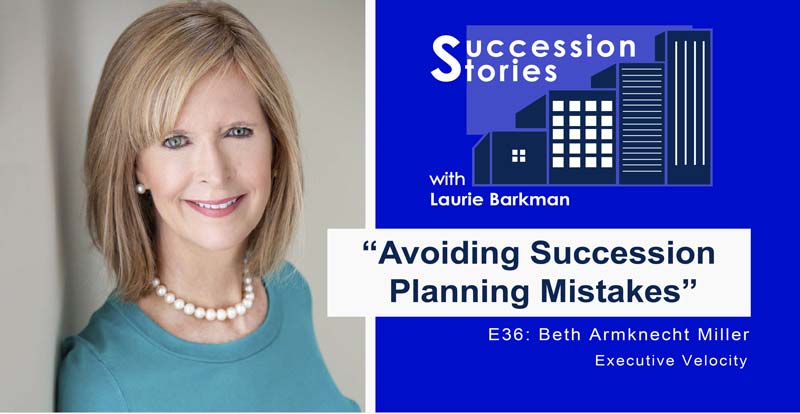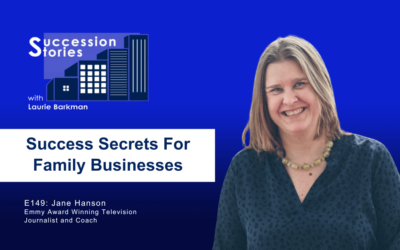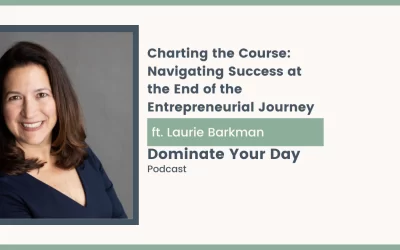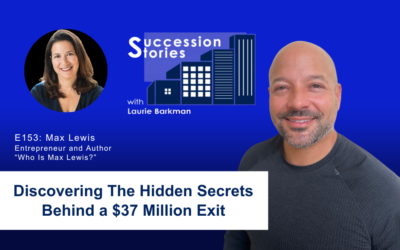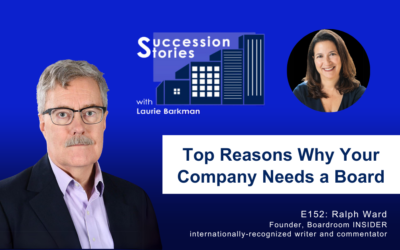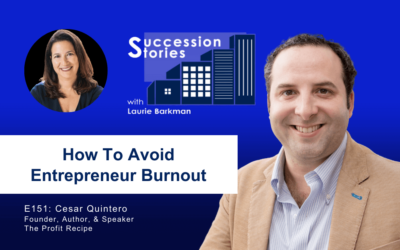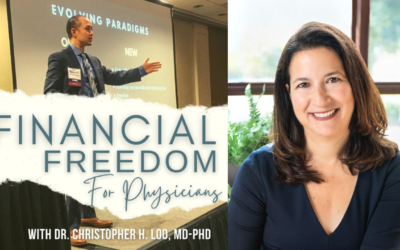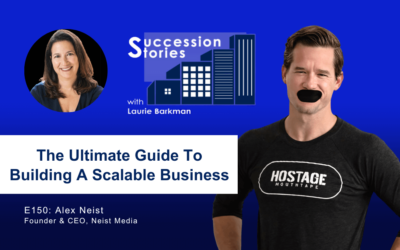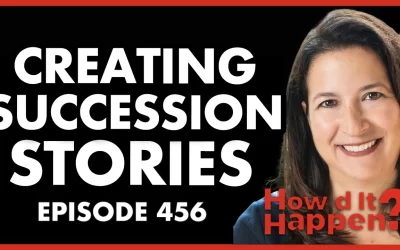Listen to the episode:
On this episode of Succession Stories, Laurie Barkman is joined by Beth Armknecht Miller, CEO of Executive Velocity, to unpack the issues surrounding succession planning. This episode delivers insights how to prepare for succession by identifying, addressing and avoiding the most pressing mistakes that can arise for business owners and entrepreneurs.
Listen to learn more about:
- Understanding the succession planning process
- Differentiating between high potentials and high performers
- Why succession planning is part of overall strategic business planning
- Planning and succession tools
Show Notes:
Executive Velocity website – Resources
Beth Armknecht Miller on LinkedIn
Succession Planning 9 Box Grid
Succession Stories E29 – CEO Succession & Letting Go
Connect with the host, Laurie Barkman on SmallDotBig.com and sign-up for an insights newsletter to build value in your company.
Subscribe to the podcast
Subscribe wherever you listen, Apple Podcasts, Google Podcasts, Spotify, Stitcher, and more.
If you enjoy the episode, please give a 5-star rating and review to help others find the content. Here’s a quick how-to guide for Apple Podcasts/iTunes online.
Transcript:
Laurie Barkman:
Welcome to Succession Stories, insights for next generation entrepreneurs. I’m Laurie Barkman. I’ve spent my career bringing an entrepreneurial approach to mature companies struggling with change as an outside executive of a third generation, 120 year old company, I was part of a long-term succession plan.
Now I work with entrepreneurs, privately held companies, and family businesses to develop innovations that create enterprise value and transition plans to achieve their long-term goals. On this podcast, listen in as I talk with entrepreneurs who are driving innovation and culture change. I speak with owners who successfully transitioned their company and others who experienced disappointment along the way.
Guests also include experts in multi-generational businesses and entrepreneurship. If you are a next generation entrepreneur looking for inspiration to grow and thrive, or an owner who can’t figure out the best way to transition their closely held company, this podcast is for you.
Subscribe to our newsletter for more resources to build value in your business and plan your transition. Visit SmallDotBig.com and sign up today.
Laurie Barkman:
This past year, some high profile companies put a spotlight on succession, most notably Amazon and Apple. Only 42% of small-midsize businesses have succession plans, and just 2 out of 10 companies say their succession planning is effective. This week I talked with Beth Armknecht Miller, founder of Executive Velocity, a leadership development and succession planning advisor, about how to avoid succession planning mistakes in closely held companies. Beth shares helpful insights for do’s and don’ts, and ways to formalize an approach for talent management.
Laurie Barkman:
Beth, welcome to Succession Stories. I’m really glad to have you on today.
Beth Armknecht Miller:
Well, thank you. I’ve really been looking forward to this, Laurie.
Laurie Barkman:
It’s great to talk with you because you have such amazing experience working with executives, and coaching and advising and succession planning. A lot of what I heard from my audience when I asked them for questions, certainly there were questions about COVID, and the other set of questions were around leadership. I thought it’d be great to have you on today to talk about those two things. But let’s start with you. If you can start by telling me about your path. Because you created your own company, you created your own consulting company. But that wasn’t right out of the gate. So I’m curious to hear your story about how you decided to do that.
Beth Armknecht Miller:
Well, actually, the reason I started the company Executive Velocity was because my husband had started a company years prior and he had convinced me to leave Coopers & Lybrand and start a consulting division. He was doing accounting, temporary services firms. So he’s really the entrepreneur, not me. We sold the business back in 2002 and I got bored pretty quickly, and decided to look for something new. But I also knew that working on my own for so long that the idea of going to work for somebody again was just not in the cards.
I was talking to a friend of mine here in Atlanta, who had been a member of Vistage, which is a CEO membership international organization. He really credited the organization and the group that he was in to the growth of his company, which at the time, when he started, was like two or three million dollars, and when I was having conversation with him, it was over $100 million. So I mean, a serious growth. Fast forward, I became a Vistage chair back in 2006 and really found my passion of working with smaller companies. Those companies generally are 30 employees, upwards of 300 to 400 employees, and helping them build leadership pipelines. The work I did with Vistage also included business consulting because I had run a company before and I had run into a lot of the same issues that they had. So I could really be empathetic and also help them navigate through some of those issues. But the group obviously helped as well. The coaching that I did, led me to realize that I want to learn more about coaching and developing leaders.
So I became certified as a coach and then went and became certified in a number of assessment tools, including Myers Briggs, Hogan and EQ-i, which actually I’ve just recently got certified. I’ve been using the book called Emotional Intelligence 2.0 out of TalentSmart, but then moved to an assessment tool called EQ-i. Emotional intelligence is a huge factor in leadership success and I am often called in to coach because of some gap in emotional intelligence. In fact, I was just talking to a new client the other day, and the woman that I’ll be coaching has some challenges around managing her emotions, and also adapting to the needs of others.
Laurie Barkman:
Well, that’s not relatable, right?
[Laugh]
Everybody in the audience is probably shaking their head going, “Yeah, okay, we get it. Who doesn’t have complete control of their emotions?”
Beth Armknecht Miller:
Exactly.
Laurie Barkman:
Well, those are some really interesting attributes and things that you can do to help develop leadership and help people look in the mirror to see what they need to work on.
Beth Armknecht Miller:
Right.
Laurie Barkman:
That’s step one, just just admitting, “Hey, this is an issue of mine.”
Beth Armknecht Miller:
Yes. Self Awareness. That’s something I always look for when I have initial conversations with new coachees. If they’re not self aware, there are going to be challenges and making adjustments and changes to their behavior.
Laurie Barkman:
Tell me more about that. How do you get them to be self aware?
Beth Armknecht Miller:
So one way is through 360 assessments. Now, that’s a challenge in smaller companies that have less than 50 employees because you’re not going to get enough data to support the feedback. But 360s can be very beneficial. It provides individuals with 360 feedback, meaning that they’re getting feedback from their peers, their direct reports, from their managers, collaborators, and in some situations, even their clients, customers. I’m doing a couple right now where the leader has asked a number of their clients for feedback, which I think is a great way to get full feedback.
Laurie Barkman:
Especially if it’s independent, and hopefully it’s anonymous feedback, because the client might feel that they can’t truly be honest.
Beth Armknecht Miller:
Yeah, and it is all confidential and anonymous. The individual just gets an aggregated score. So they’re not able to see who’s saying what. But I will tell you that, oftentimes, they will read comments, they’ll go, “Well, I think that was so and so.” I’ll say, “Well, you know, does it really matter?” Because it’s feedback; this additional information that you should be taking in.
Laurie Barkman:
Well, there’s two things you can do with feedback. There’s the circular file. There’s the trash can, and then there’s to take it to heart, and there’s probably something in between. Do you find that people, even if they’re getting in black and white on paper that this is feedback, do they have a tough time believing it or internalizing it?
Beth Armknecht Miller:
Sometimes it depends on the feedback. I remember working with one individual, and he got some really tough feedback and it was a surprise to him. But he took it to heart and he realized that this was the perception of the people that were giving him the feedback and that that’s reality to them. So he needed to figure out how to adjust and adapt to the styles of other people.
Laurie Barkman:
Right?
Beth Armknecht Miller:
Yeah.
Laurie Barkman:
So the show theme, as the name insinuates – Succession Stories – I love to talk about transitions and succession. Succession can be in a general company setting, it doesn’t have to be a family business but I’m curious if you’ve seen any differences with working with clients of those two categories. Where it’s just it’s a privately held company, maybe founder led versus this is second generation, third generation, etc.
Beth Armknecht Miller:
I have found that family businesses are a bigger challenge. You’ve got personalities that have known each other for years, there’s more emotion involved, and there are alliances that can come into play. In fact, I was just talking to a gentleman earlier this morning, who is in a family business, and I think he’s Third Gen. Yeah, he’s third generation and he’s having to deal with a lot of the problems that occurred in earlier generations. He feels like he’s having to clean up, because the family itself wasn’t willing to make the hard decisions as it related to elevating family members and placing them in positions that either they weren’t ready for, or they were never going to be ready for.
Laurie Barkman:
And that’s a tough thing to tell someone, they’re never going to be ready. I heard someone yesterday, I was on a webinar. Some family business owners, some of them had sold their company. One gentleman told a story about how he had to let go of one of his sons, because the son wasn’t performing.
It took about six months and then after he let his son go, it took another three months for emotions to subside. Then he said, “After that everything was fine, because it was the right thing to do.” It was the right thing for the son, and the son ended up going to create his own business. He’s entrepreneurial and he found his path somewhere else. But it’s really tough to make that call.
Beth Armknecht Miller:
Yeah, it is. Parent and child relationships are so close and you don’t want to hurt your child. But at the same time, long term, in this case, in a lot of cases, it’s a much better choice. Because oftentimes, those kids are in the business, sometimes because they feel obligated, that they didn’t really have a choice. I have actually a friend/client over in Louisiana and one of the things that he was really good about in bringing his kids on board was that they couldn’t just immediately come to work for him. They had to get a degree that made sense with what they were doing, which was an engineering company. They had to go off and work five years somewhere else before they actually came to work for the organization and that’s worked very well for him.
Laurie Barkman:
Yeah, I’ve heard that too. Where people need to go work elsewhere before entering the family business. Then there’s a path for them, hopefully with mentoring. I’ve heard that’s a really important aspect.
Beth Armknecht Miller:
Yeah. Mentoring and coaching, I find are really important in small to midsize companies for developing. But it’s really important that you have a really strong development plan, and to understand, what are the competencies that the individuals are bringing to the table? What are those competencies that he or she may be missing, that need to be developed in a timeline that will prepare them for their next position in the right time frame?
Laurie Barkman:
Yes, that makes sense. So the process of succession planning, can you just explain at a high level, how it works? Is it something that’s done in a day, done in a year, five years? How does it work?
Beth Armknecht Miller:
So the succession planning process is an ongoing process. You need to integrate it with your business plan, and your business planning process. So the succession plan should be a subset of your business plan. It needs to be driven by what I call the succession planning team, which is a high level group of leaders, along with an HR talent management person who understands the process, and can facilitate what I call the talent discussions, the talent conversations, where you bring the team together, and discuss potential versus performance.
That’s one big mistake I see smaller businesses make. They get confused with high performers and high potentials and they don’t equate. In fact, I read somewhere it’s like one out of seven high performers actually have the traits of high potentials. So you’ve got to be really clear of what potential is in your organization and that’s forward looking versus performance, which is past and historical looking. So get really clear about that, and then have the conversation around who is a high performer or a high potential. Where are they in the organization? Are they in a key position? That’s another mistake that I see people make. They look at the key employees, versus the key positions.
First, the conversation I was having just earlier with this gentleman in the family business, they did create a future organizational chart. But there were no names in it and there were people that actually were in some of those positions. Then some of those positions don’t even exist yet. They’re going to be needed in two or three years. So they have this map that they then need to start placing employees into the map. But it also requires development. So if you’ve got, for instance, a controller, and you believe that you need a CFO in a year or so, there are some clear skills gaps between a controller and a CFO. So what kind of development are you going to provide that individual so that he or she can move into that position, versus you having to go out and hire somebody?
There’s a tool that’s called a Nine Box Grid, which is one of the key tools to use. Basically, one axis is performance, the other axis is potential. In the talent conversation, you start plotting your employees in this nine box grid, then what you do is you then move those names to the key positions. You’re able to then start seeing, okay, we might have one or two people that are available for this position in the future. How do we start developing them? So the developing is ongoing. You’re continually measuring the performance and the development of those individuals to align with your succession plan. So if you’ve got somebody that you feel is going to retire in five years, well, you’ve got five years to develop that individual or individuals. If you’re lucky enough, where you’ve got two or three people, you’ve got a larger organization, then you are measuring them as they develop, and it’s a continuous talent conversation.
Laurie Barkman:
I love how you’ve described that. I think there’s a couple of key things here. One is that a succession plan is a subset of the overall strategy plan or business plan and that’s a point that I like to reinforce with the audience that it doesn’t sit alone. The way you described it was so great, because you’re right. You have to be future thinking. You can’t just look at someone’s past performance and say that that’s an indicator of the future. It’s certainly important. But if the future skill set, or if the role is just so different for them individually, you really have to figure that out. That might be a gap. That was my experience, too, when I worked for a very, very large company that people would know the name of if they heard of it, but they have an excellent process, and they use the nine box. We did that with our teams to talk about future potential. So I can visualize that and I’ll include a link to that in the show notes for folks that may not be familiar with the nine box grid. But, transitioning here. On the talent side of the employee side, do you find that typically, they are in the loop? That they know that there’s this grander plan being discussed about them?
Beth Armknecht Miller:
No, I think part of it is, leaders are concerned that if they start having this conversation around “We want to prepare you for this next position” and things don’t go right, then they’ve got to have a more difficult conversation. What I really encourage companies to do is, first of all, to communicate to all employees about what potential looks like to the organization. What are the behaviors that they are looking for in employees that would show them that they have potential to move, either move up or across and take on some other role that will expand their career? It doesn’t have to be up, and that I think that’s really important. Especially today, where there’s so many companies that are a lot flatter, and you need to, instead of looking at the performance and the pathway of an employee up, it could be a latticed effect where they’re moving across and up. Or you’re enriching their job, where you’re expanding what they already have, with adding on additional responsibilities. That may mean a larger team. So it’s not just about moving up.
Laurie Barkman:
I think the conversation really, we could debate this, I guess there’s no one answer. But for high potential people who are really contributing at a high level in an organization, they want to know what their future entails at that organization. Otherwise, they might say, “I’m going to move on to greener pastures, I’m looking for more opportunity.” So yeah, there’s a push and a pull on that.
Beth Armknecht Miller:
Yeah and I definitely encourage career conversations with all employees. Whether they’re your average performer or high performer or high potential. Those career conversations will allow you to understand what they are looking for, and then how can you help them get there. But the critical thing is to make sure that you don’t make promises that you can’t keep.
Laurie Barkman:
That is the point. So you’re talking about their career intention, what they aspire to their hopes and dreams but not promising, “You’re going to be VP or you’re going to be CEO,” unless it’s really in the cards for them. Right?
Beth Armknecht Miller:
Yeah. There are some high potentials out there that don’t really want to take on another higher level position, oftentimes, for personal reasons. They’re at a point where they feel like they need to step back, there might be something going on in their personal life. You need to understand where they are in their lives before you assume that, “Oh, gosh, here’s this high potential, we need to move him or her into the next position.” It might also mean requiring a lot more travel and maybe they’re not up for that. There’s all sorts of aspects to their personal decision.
Laurie Barkman:
So switching gears a little bit to talk about COVID-19, and the impact that you’ve seen on small businesses, medium sized businesses. That they’ve had to deal with changes in this new environment. Maybe they’ve had to lay off key employees that they wouldn’t otherwise have done six months ago. What have you seen on the talent side in terms of impact to companies?
Beth Armknecht Miller:
I’ve seen both sides, meaning I’ve seen some people where they’ve actually been hiring. I was just talking to a gentleman out in California. They do large HVAC systems. So they do engineering and actual construction, and they’ve been hiring. There have been other smaller organizations that have had to let go. And they’ve seen that opportunity and they’ve been able to take on new talent. Now, on average, that’s not what’s happening right now. Unfortunately, it’s more the reverse, where people are having to downsize as they wait for the economy to rebound. Having to let go of anybody, whether or not it’s for performance or not is difficult. It’s especially difficult when it’s totally out of their control. We’re all dealing with COVID and we’re all being impacted some way. So the conversations that they’re having, they’re trying to do it, and oftentimes with furloughs versus letting people go. But they’re now at a point where I see them making some final decisions. They furloughed people, and now they’re feeling like, “Okay, you know, PPP is running out, I need to make some decisions in order for the good of the organization to be healthy.”
Laurie Barkman:
These are tough decisions that companies are making, like you said. Is it performance based? Is it tenure based? It may be a combination of things and it’s hard to know. But I wonder about the impact on the remaining people in the organization. They might feel guilty that they have their job and their colleagues don’t. They might be sad. There’s a lot of emotion there. We started this conversation talking about the emotional quotient, the EQ. What kinds of conversations have you been having with CEOs and leaders of these companies to help them through the emotional side of COVID?
Beth Armknecht Miller:
Well, one of the issues that I see, as it relates to the leaders specifically is, they’re exhausted. They’ve used up a lot of their emotional energy reserves and they need to be able to step back and regenerate. I spend a lot of time with them, exploring how do you in short periods of time, get some time for yourself, and be able to balance the needs of your employees with the needs of yourself. It’s the old adage of put the oxygen mask on first, before you try and help somebody else. If employers, if leaders can’t help themselves how do they have the energy to help others? There’s some that have been struggling with that. They’re the ones generally that are in those smaller organizations that have some huge financial strains. It’s almost like they’re on the edge and it’s really difficult to have those conversations with them. Really hard.
Laurie Barkman:
I can imagine. If they’re feeling on the edge financially, they’re probably losing sleep. They’re not eating, taking care of themselves, and then that’s just going to be a downward spiral.
Beth Armknecht Miller:
And their decisions aren’t as good either. Because they’re cloudy. They’ve got all this other stuff around them.
Laurie Barkman:
Right. Yeah. That’s not a good place to be. The organizations that are finding a way through that, getting the balance sheet squared away, not having the capital that they need to be able to move forward, and then thinking about what’s next. They’re the ones that are going to come out of this and be more ready to take on what the marketplace dynamic looks like over the next six to 12 months.
Beth Armknecht Miller:
Yeah, and I’ve also seen something else with those individuals, those companies, and they’re a lot more agile. They’re looking at the landscape and saying, “Okay, what opportunities am I missing that I could go after that maybe I didn’t in the past because I didn’t need to, but now there are market opportunities there that I probably should pursue?”
Laurie Barkman:
Yeah, and then that fits back with, what’s the need and the organization? Maybe they need people who are more intrapreneurial or entrepreneurial.
Beth Armknecht Miller:
Exactly!
Laurie Barkman:
Whereas in the past, it was, “Hey, do this, do it well, this is how it works.” Now it’s more about “What new services might we need? What new products might we need? How do we talk to our customers?” So I think then, again, it stitches back to the strategic plan and I think it’s a great time for organizations to take that step back. I led a session the other week, and at the end, we recapped and said, “How did you feel about today?” and it was words like “energetic, positive, looking ahead.” Things like that. Whereas probably a week ago, or two weeks ago, it still would have been more status quo. Working from home than they were connected with their team, they were feeling this hopeful sense of moving forward. I think now more than ever, it is a great time to kind of bring the teams together and talk about what’s next. What can we do to be adaptive, and as you said, agile. That’s a really important thing, and as they think about the type of leadership they need, they might be modifying that skill set.
Beth Armknecht Miller:
Right. They need to find leaders that are agile and willing to change and have that vision for the future.
Laurie Barkman:
Yeah, that’s important. Let’s talk about values. I think values drive behavior, and certainly incentives and alignment in an organization. Regardless of whether it’s a family business or not, they need values to have as the pillar or the foundation. How have your clients’ company values driven their decisions at this time during the pandemic?
Beth Armknecht Miller:
I think the ones that are the strongest, from an organizational standpoint, are always going back to their values. Asking the question, “Okay, does this decision match our values?” and that they have that conversation as a group, as a leadership team. They drive values through the organization on a really consistent basis. The gentleman in California was talking about how they’re a fairly new organization, they’re only been around for about six years, but they’ve managed to grow very significantly. He had a little brochure that had the mission, the vision, the values, and then the specific behaviors, which I thought was excellent, because a lot of companies will have their values, but then they don’t drive it down to “What are the behaviors that show us that you are representing the values?” And so he had a list, it was pretty specific, and all the managers had those. What he’s doing is, he is bringing out one of those values in each meeting, and reinforcing it, as they’re making decisions. So that’s a great way of doing it.
Laurie Barkman:
It’s a great way. I like that a lot. I worked for a company that did that. It specifically called out all of those elements; mission, vision values and behaviors, and especially for one of the companies I worked for, safety was one of the values and safety was certainly one of the behaviors. Anytime they had an important leadership meeting, they would make sure to mention where the safety exits were, I mean, you could take it at any level of manufacturing or an office environment. But if you think about COVID-19, if safety is one of your values, it will certainly drive the behaviors and decisions about the working environment and how they treat their staff and their clients and how to protect them. So I think that call out about behaviors is a really good one. The only other thing I wanted to mention about that, as you were talking, I was thinking about this two way street nature of behavior. Because you can’t outline the behaviors and then have the leadership team not abiding by that because people see that a mile away, and they’ll call it out.
Beth Armknecht Miller:
Right? Oh, yeah. They need to definitely model the behaviors that they’re insisting others do as well. Then from a succession planning standpoint, I always then take a look at those behaviors and help an organization create those competencies that are related to the behaviors, because that then helps you in the conversation around performance and potential. It also helps you in your hiring process. If you’re clear about the competencies that anybody or everybody needs within the organization, then you can have really good questions to ask potential employees candidates for positions.
Laurie Barkman:
Yeah, they definitely tie back. That makes a lot of sense and on a different show, I’m going to talk to an executive recruiter who works with family businesses. So this is a great segue to this next episode that we’ll have and I’ll make sure to tie them together in the show notes. So competencies are important and I think that this is probably a great place to talk about you and your business. How do people find you online, if they want to learn more about succession planning, competency development, and leadership?
Beth Armknecht Miller:
Well, they can find me on LinkedIn. They would look me up as Beth Armknecht Miller, I’m the only one there at Beth Armknecht Miller, and then my website is executive-velocity.com. I have a lot of free resources on my website, just go to the resource tab. I’ve got resources on hiring, leadership and succession planning. So help yourself to all the resources out there.
Laurie Barkman:
Oh, well, thank you. That’s awesome to have. People want to learn more about succession planning and others know one way to do it, but there’s a lot of best practices that you’re sharing. That’s a great resource. So last question for you. Because you’re a business owner, and you are an entrepreneur, do you have a favorite saying about entrepreneurship?
Beth Armknecht Miller:
I guess it would be something around, “If you think you know what you’re doing today wait for tomorrow.”
If you think you know what you’re doing today, wait for tomorrow.
Laurie Barkman:
Because it’s always gonna change. Change is constant.
Beth Armknecht Miller:
That’s right.
Laurie Barkman:
That’s great. Thank you so much for being with me today. I really appreciate you and I appreciate you coming on the show.
Beth Armknecht Miller:
Well, I enjoyed it. Thank you so much for inviting me.
Innovation, transition, growth. Easy to say but hard to do.
If you’re an entrepreneur facing these challenges. I get it. I work with businesses from small to big for strategic planning with your team to achieve your vision.
Visit smalldotbig.com to schedule a call with me. I’d love to connect with you. Be sure to catch the next Succession Stories episode with more insights for next generation entrepreneurs.
Thanks for listening.

